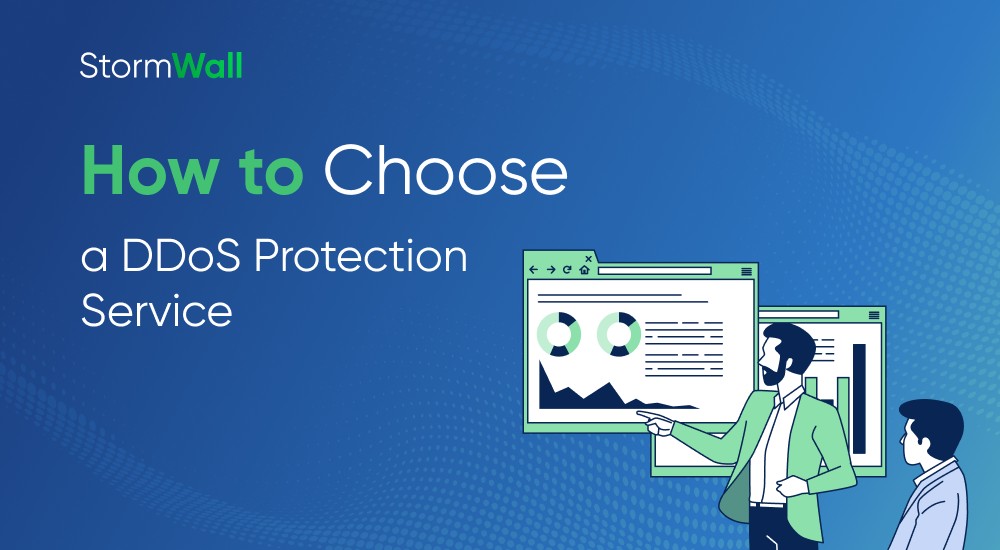In July 2024, Microsoft spent nearly 10 hours restoring its Azure services after a DDoS attack. According to estimates from Zayo, each minute of cloud downtime costs around $6,000—meaning the tech giant may have lost over $3.5 million in a single incident. And that’s without factoring in the reputational damage and customer dissatisfaction.
So how can you avoid making the same costly mistake? Which DDoS protection service should you choose—and how do you make the right choice? We answer all these questions in this article.

Many of the technologies and solutions used a decade ago struggle to keep up with the scale and speed of today’s DDoS attacks. As the threat grows, so does the demand for modern protection tools. As a result, more companies are turning to specialized services—often opting for cloud-based DDoS protection solutions.
Still, choosing the right protection is far from simple. The global market offers dozens of providers, most of which showcase impressive case studies, technical expertise, and a strong reputation.
But in practice, evaluating all options can be extremely challenging. One key reason is that providers use different methods to measure the effectiveness of their solutions, making it hard to compare offerings on equal terms.
There’s also an internal challenge: most companies lack in-house specialists who truly understand the nuances of DDoS mitigation. Decision-makers often rely on sales promises—and that can backfire. Businesses either overspend on unnecessary features or find themselves vulnerable when a real attack hits.
What Kind of Anti-DDoS Service Do You Need? Your Checklist
Below are eight essential questions to ask DDoS protection providers. They’ll help you evaluate different options more objectively and choose a solution that truly fits your business needs.
1. What OSI layers does the service protect?
L7: Application-layer DDoS attacks are precise and often target login pages, shopping carts, or specific URLs. Basic traffic filtering is no longer sufficient. Make sure the service includes modern traffic analysis—especially machine learning-based filtering that can identify and block malicious behavior in real time.
Read also: How to Stop Application L7 DDoS Attacks
L3–L4: At these layers, the provider should be able to mitigate UDP and SYN floods, as well as traditional amplification attacks using services like DNS, NTP, and Memcached. It’s critical that malicious traffic is filtered before it reaches your network—since even the access channel can become a bottleneck and cause downtime.
2. Filtering Capacity
To assess the provider’s ability to handle real-world attacks, ask these three key questions:
- What is the total network throughput of the filtering infrastructure? The higher the number, the lower the risk that your protection will be affected by other customers’ traffic or simultaneous large-scale attacks. Greater capacity ensures your service remains stable even when multiple clients are under attack.
- Can the provider block your IP address or connection to protect their own infrastructure? If yes, under what conditions? Clarify when and why such a scenario might occur. This helps you understand the potential risk of complete service disruption in extreme cases and how it might affect the provider’s scalability and performance headroom.
When choosing a service, it’s also important to consider performance headroom. During a real DDoS attack, malicious traffic volumes can greatly exceed your current peak load. The higher the filtering system’s capacity, the more likely it is to withstand not only today’s threats but also larger-scale attacks in the future.
3. Filtering Network Geography
Ideally, the scrubbing center should be located as close as possible to your company and your end-users. This ensures not only faster filtering of malicious traffic but also low latency for legitimate users.
At the same time, a good provider should also operate scrubbing centers in regions where potential attacks might originate. With the growing presence of botnets and hacktivist groups worldwide, malicious traffic can now originate from virtually any country. The more geographically diverse and well-distributed the provider’s infrastructure, the faster and closer to the source it can filter attack traffic—reducing the load on your network.
4. Response Time
Modern DDoS attacks can escalate within seconds, so an effective protection service must be capable of analyzing traffic and activating mitigation automatically and in real time.
Be sure to check what response time guarantees are outlined in the provider’s SLA. Pay close attention not only to the stated response time but also to how it applies to different types of attacks. It’s important that the SLA covers not just single-layer attacks, but also complex, multi-vector DDoS attacks that often require more time and advanced strategies to be fully mitigated. These sophisticated attacks are increasingly common and demand a provider capable of delivering sustained, adaptive response.
5. Pricing Models
Most anti-DDoS providers operate with predefined pricing plans, but the actual pricing structure itself can vary significantly. Here are the main pricing models and how they differ:
| Model | What is it | Pros | Cons | Best for |
| Pay-as-you-go | You pay only for actual usage, such as the volume of filtered traffic. | Cost-effective for infrequent attacks; no recurring subscription fees. | Cost can escalate with frequent attacks. | Businesses experiencing DDoS attacks only occasionally. |
| Fixed Subscription (Monthly/Annual Plan) | A flat monthly or annual fee for a defined protection level, usually with bandwidth limits. | Predictable costs; easier to budget and manage. | May be excessive for businesses with rare attacks, potentially leading to overpayment. | Companies facing regular DDoS threats. |
| Tiered Pricing | You buy a base protection package (e.g., 10/50/100 Gbps) and pay extra if you exceed that limit. | Controlled spending with flexibility for handling occasional traffic spikes. | Requires monitoring quotas to avoid unexpected charges. | Large companies that face consistent DDoS activity. |
| On-Demand | Infrastructure is pre-configured but activated (and billed) only when an attack occurs. | Ideal for rare but large-scale attacks. | May experience activation delays when an attack begins. | Companies with rare but potentially severe threats. |
Some providers also offer customized pricing options based on your specific risk profile and budget. It’s a good idea to ask whether an upper cap is available—this is a maximum charge limit beyond which you won’t be billed, even in the event of an exceptionally large attack.
6. Flexibility of Protection Settings
This is one of the most critical factors affecting the effectiveness of DDoS protection. The better a service adapts to the specifics of your infrastructure, the more reliable it becomes.
When evaluating a provider, be sure to ask:
- Can basic filtering rules be customized? For example, can you define custom thresholds for different traffic types and OSI layers, or customize how analytics and logs are displayed?
- What level of control do you have? Will you need to contact support for every change, or can adjustments be made independently through a control panel or API?
- Are automated adaptation scenarios supported? It’s important that the provider offers AI/ML-based mechanisms that can be fine-tuned to detect and respond to new attack vectors.
This level of flexibility helps ensure more accurate protection and fewer false positives—especially in dynamic environments where traffic patterns are constantly evolving.
7. Trial Period
Ask whether the anti-DDoS provider offers a free trial period of their service. A refusal might raise red flags—there could be usability issues or limitations in functionality they prefer not to expose.
Most providers typically offer a trial period ranging from 7 to 30 days. Use this time to evaluate the user interface, test the system’s behavior during a simulated DDoS attack, check the false positive rate, explore the flexibility of protection settings, and assess other key performance aspects.
8. Technical Support
With any anti-DDoS service, you’re also relying on the provider’s technical expertise. Many vendors offer 24/7 support and have been in the market for years—but how responsive and effective is their support team?
To evaluate this, consider the following:
- What communication channels are available? Messaging apps are usually faster than email or phone.
- Does the support system have tiered levels (e.g., L1, L2)? This ensures that more complex issues are handled by experienced engineers.
- What is their guaranteed response time? Ideally, it should be no more than 15 minutes.
And finally, if you’re considering an international provider, make sure their support team can assist you in your preferred language—especially if you or your team aren’t fluent in English.
In Conclusion: Focus on What Matters Most
When choosing a DDoS protection service, take a pragmatic approach—just as you would with any other enterprise software. Carefully weigh the financial risks and benefits, assess the technical capabilities, and consult your internal teams.
At the end of the day, an anti-DDoS service is a critical part of your infrastructure. Its performance directly affects the availability of your digital assets, the continuity of your business operations, and the long-term growth of your company.

DDoS Protection for Websites
- Activate protection in 10 minutes
- 24/7 technical support




















